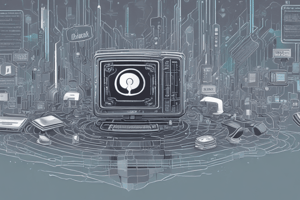Podcast
Questions and Answers
Which desktop environment is known for being more lightweight and ideal for older computers?
Which desktop environment is known for being more lightweight and ideal for older computers?
- Xfce (correct)
- KDE
- Cinnamon
- Unity
What is a notable characteristic of KDE compared to other desktop environments?
What is a notable characteristic of KDE compared to other desktop environments?
- It requires a powerful GPU to function.
- It has many configuration options and features. (correct)
- It has fewer configuration options.
- It is similar to macOS in layout.
Which desktop environment was developed specifically for Linux Mint?
Which desktop environment was developed specifically for Linux Mint?
- GNOME
- KDE
- Xfce
- Cinnamon (correct)
Which command would you use to display the user manual of any command in the terminal?
Which command would you use to display the user manual of any command in the terminal?
What is the purpose of the 'file' command in Linux?
What is the purpose of the 'file' command in Linux?
What is the main advantage of using the Command Line Interface (CLI) over the Graphical User Interface (GUI) in a Linux environment?
What is the main advantage of using the Command Line Interface (CLI) over the Graphical User Interface (GUI) in a Linux environment?
Which of the following best describes a Linux distribution (distro)?
Which of the following best describes a Linux distribution (distro)?
What programming language was UNIX originally written in?
What programming language was UNIX originally written in?
Which Linux desktop environment was once the most popular and used by default on multiple large distributions?
Which Linux desktop environment was once the most popular and used by default on multiple large distributions?
What is a significant challenge faced by new users when using the Command Line Interface (CLI)?
What is a significant challenge faced by new users when using the Command Line Interface (CLI)?
Flashcards are hidden until you start studying
Study Notes
Operating System Overview
- An operating system (OS) consists of all programs necessary for computer operation and application control.
- UNIX was originally written in C, primarily for scientific and technical applications on mainframes and workstations.
- Linux, developed by Linus Torvalds, is a family of UNIX-like open-source operating systems.
- Linux distributions (distros) combine the Linux kernel with additional software, offering a cohesive user experience and specific functionality.
Shells in Linux
- Shells provide interfaces between users and the operating system kernel.
- Two primary forms of shells:
- GUI (Graphical User Interface): Enables interaction through graphical icons, easier for new users.
- CLI (Command Line Interface): Users execute commands through text; offers more control and scripting capabilities but has a steeper learning curve.
Popular Linux Desktop Environments
- GNOME: Lightweight and once the default for major distros like Ubuntu and Fedora.
- KDE: More complex than GNOME, emulates Windows with extensive configuration options and features.
- Xfce: Lightweight and traditional, suitable for older systems with limited graphical capabilities.
- Cinnamon: Developed for Linux Mint, offers a modern desktop experience with traditional aesthetics.
Basic Linux Commands
- man: Displays manuals for commands.
- file: Identifies file types.
- whatis: Provides brief descriptions of commands.
- whereis: Locates files and command pages.
- whoami: Shows the current user.
- ls: Lists files and directories with detailed metadata.
- tree: Recursively shows directory contents.
- pwd: Displays the current working directory.
- cd: Changes the current directory (uses different shortcuts for navigation).
- mkdir: Creates a new directory.
- rmdir: Deletes an empty directory.
- cp: Copies files to a specified location.
- mv: Moves files to a specified location.
- rm: Removes a specified file.
File Management and Structure
- Files are organized in a tree-like structure called the filesystem.
- Types of files:
- Ordinary Files: Contain data, text, or program instructions.
- Directories: Store ordinary and special files; similar to folders in other operating systems.
- Special Files: Provide access to hardware and act as aliases.
Key Linux Directories
- /: Root directory from which all other directories branch off.
- /dev: Contains device files; many generated at boot.
- /etc: Hosts system configuration files.
- /bin: Includes essential binaries and applications.
- /home: Contains user home directories.
- /boot: Files required for system startup.
- /lib: Libraries needed by applications.
- /usr: Houses user files and applications.
- /opt: Common location for compiled software.
- /proc: Virtual directory with real-time data about the system.
- /tmp: Temporary file storage.
- /sbin: Contains system binaries for superuser access.
- /var: Holds variable files, such as logs and spool files.
Studying That Suits You
Use AI to generate personalized quizzes and flashcards to suit your learning preferences.



